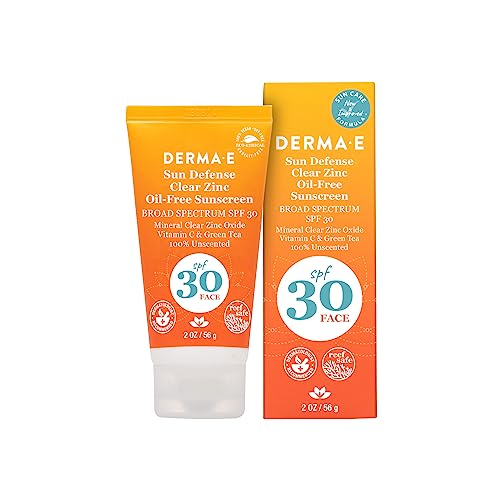
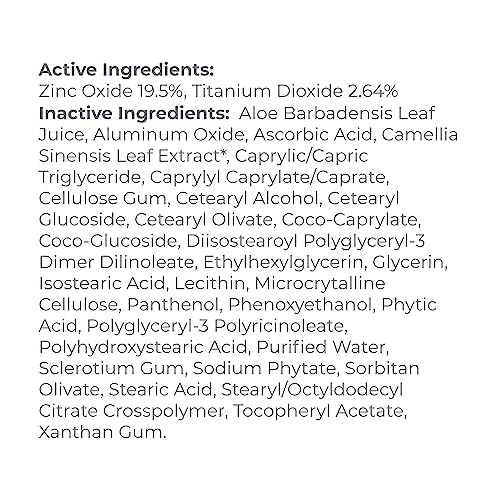
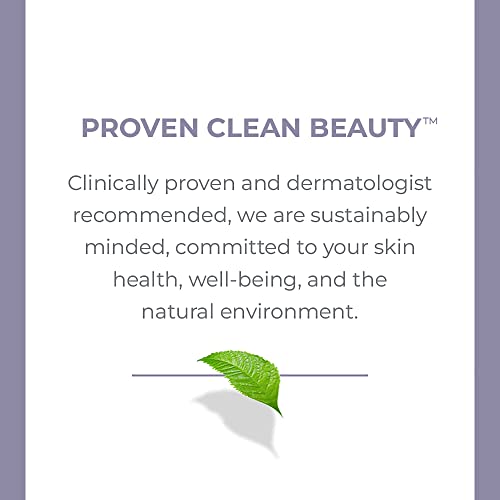
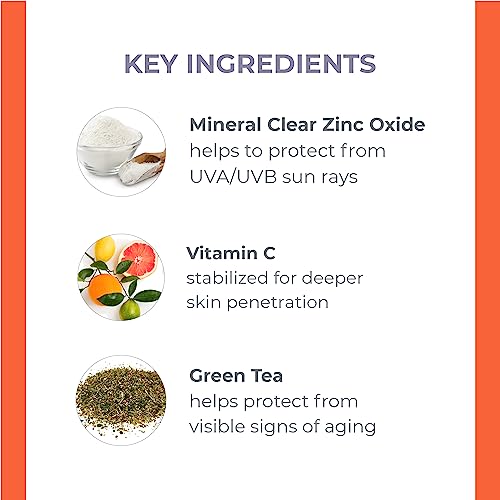
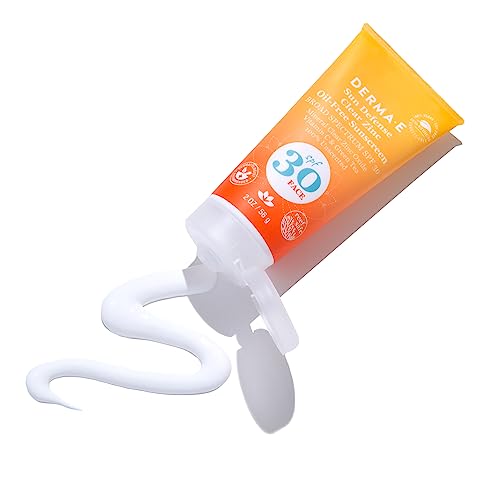
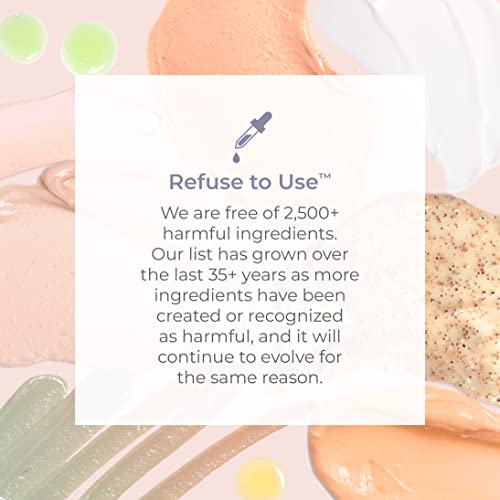

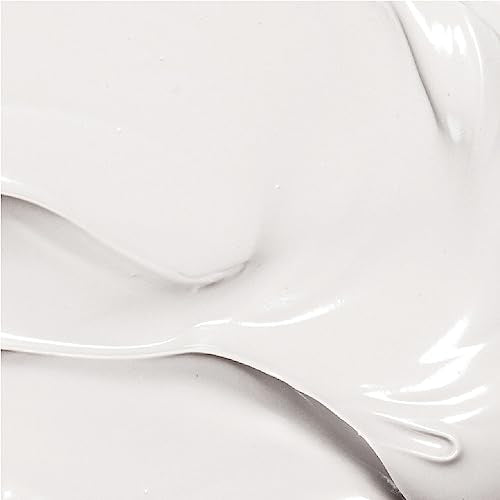
DERMA E Mineral Sunscreen SPF 30 - Oil-Free, Hypoallergenic Clear Zinc Protection - 2 Oz


Benzyl Alcohol
High RiskBenzyl alcohol is a naturally occurring and synthetic aromatic alcohol commonly used as a solvent, preservative, and fragrance ingredient in various products. It is found in both plant sources and as a synthetic compound, functioning primarily to maintain product stability and enhance fragrance profiles.
Sustai Insights
Benzyl alcohol serves effectively as a preservative and solvent, contributing to product stability and sensory qualities. However, it poses potential health risks, particularly as an allergen, with high concern for immunotoxicity. Environmental risks include being a pollutant with low bioaccumulation potential. Regulatory agencies have established restrictions on its use in certain products. Overall, the risk level associated with benzyl alcohol is assessed as high, necessitating careful consideration of its use and potential alternatives.
Zinc Oxide(sunscreen Grade)
Medium RiskZinc oxide (sunscreen grade) is a mineral compound often used in sunscreens for its ability to provide broad-spectrum UV protection. It is micronized to improve its cosmetic feel and skin application, making it suitable for various formulations, including those designed for sensitive skin.
Sustai Insights
Zinc oxide offers effective UV protection and is generally considered safe for topical use; however, it has moderate concerns related to allergies and potential skin absorption. Regulatory bodies have noted use restrictions, particularly in specific formulations. While its environmental impact is relatively low, concerns about enhanced skin absorption warrant caution. Overall, the risk level is assessed as medium, and users are advised to follow safe application practices. Alternatives such as titanium dioxide may provide similar benefits with potentially lower allergenic risks.
Caprylyl/ Capryl Glycoside
Low RiskCaprylyl/Capryl Glycoside is a surfactant derived from natural sources, primarily used in personal care and cosmetic products for its emulsifying properties. It helps to stabilize formulations and enhance cleaning efficacy while being gentle on the skin.
Sustai Insights
Caprylyl/Capryl Glycoside offers functional benefits as a mild surfactant and emulsifier, contributing to product stability without significant irritation. It is biodegradable and considered sustainably sourced. Health risks are low, with minimal concerns regarding carcinogenicity and developmental toxicity. Environmental impact is also low, as it does not accumulate in ecosystems. Regulatory assessments indicate no current restrictions. Overall, it presents a low risk profile, making it a suitable choice in formulations.
Triethoxycaprylylsilane
Low RiskTriethoxycaprylylsilane is a silicon-based ingredient primarily used as a binder in cosmetic formulations. It helps in improving product texture and stability, facilitating the blending of various components in formulations.
Sustai Insights
Triethoxycaprylylsilane offers functional benefits as an effective binder, enhancing the stability and texture of cosmetic products. It has low concerns related to cancer, allergies, and reproductive toxicity. While there are low risks of irritation and endocrine disruption, regulatory bodies have verified its safety for use. Environmental risks appear minimal, with no significant bioaccumulation or pollutant potential. Overall, the ingredient is assessed as low risk. For safer alternatives, manufacturers may consider other silicone alternatives that provide similar functional benefits.
Hydroxystearic Acid
Low RiskHydroxystearic acid is a fatty acid commonly used in cosmetic formulations. It serves as an emulsifier, stabilizer, and thickening agent, contributing to the texture and consistency of various products.
Sustai Insights
Hydroxystearic acid offers functional benefits such as improving product stability and texture. It is generally recognized as safe, with low concerns regarding carcinogenicity, allergenic potential, and reproductive toxicity. Environmental risks are minimal, with no significant pollutant or bioaccumulation potential. Regulatory bodies have not imposed restrictions on its usage. Overall, the risk level associated with this ingredient is low. Safe usage practices involve adhering to recommended concentrations in formulations, while alternatives like natural emulsifiers may provide similar benefits.
Vegetarian Glycerin
Low RiskVegetarian glycerin, also known as glycerol, is a colorless, odorless, and viscous liquid derived from plant sources. It is primarily used as a humectant, solvent, and emollient in various personal care products, helping to retain moisture and improve texture.
Sustai Insights
Vegetarian glycerin offers functional benefits as an effective humectant, promoting hydration and skin smoothness. It is biodegradable and typically sustainably sourced. Health risks associated with glycerin are low, with no significant concerns for carcinogenicity, allergens, or reproductive toxicity. Environmental risks are minimal, and it is not subject to major regulatory warnings. Overall, the risk level for this ingredient is low, making it a safe choice in formulations. Safe usage practices include ensuring proper concentrations in products, and alternatives such as propylene glycol exist but may have differing properties.
Tocopherol, D Alpha
Low RiskTocopherol, specifically d-alpha tocopherol, is a naturally occurring form of Vitamin E. It is commonly used in cosmetic and personal care products primarily for its antioxidant properties, helping to protect formulations from oxidation and extend shelf life.
Sustai Insights
D-alpha tocopherol provides effective antioxidant benefits, contributing to product stability. It is sustainably sourced and generally regarded as safe, with low concerns regarding carcinogenicity, allergies, and reproductive toxicity. However, there are minor concerns about endocrine disruption. Regulatory bodies have not imposed significant restrictions, indicating low overall risk. Recommended usage practices include adhering to established safe concentration thresholds. Alternatives, such as other forms of Vitamin E or plant-based antioxidants, may also be considered.
Polyglyceryl 2 Dipolyhydroxystearate
Low RiskPolyglyceryl-2 dipolyhydroxystearate is a non-ionic emulsifier derived from glycerin and fatty acids. It functions primarily to stabilize and improve the texture of cosmetic formulations by facilitating the blending of oil and water phases, enhancing product consistency and application.
Sustai Insights
Polyglyceryl-2 dipolyhydroxystearate is effective as an emulsifier, aiding in product stability and texture. It is considered low risk for health concerns, including carcinogenicity, allergies, and developmental toxicity, with no current use restrictions. Environmentally, it does not appear to be a pollutant or bioaccumulative. Regulatory bodies do not issue advisories against its use, indicating a low overall risk. Safe usage practices involve adhering to typical formulation concentrations, and while alternatives exist, this ingredient is generally viewed as safe for consumer use.
Sucrose Palmitate
Low RiskSucrose palmitate is a monoester of palmitic acid and sucrose, commonly used as an emulsifier and stabilizer in various cosmetic and food products. It helps to blend oil and water-based ingredients, enhancing texture and consistency.
Sustai Insights
Sucrose palmitate offers functional benefits as an effective emulsifier, facilitating the uniform distribution of ingredients in formulations. It is considered biodegradable and sustainably sourced. Health risks are minimal, with low concerns for carcinogenicity, allergies, and reproductive toxicity. Environmental risks are also low, with no significant pollutant or bioaccumulation concerns. Regulatory bodies do not impose restrictions on its use, indicating a low-risk profile overall. For safety, it is recommended to use within established concentrations, and alternatives like other plant-derived emulsifiers may be considered for those seeking greener options.
Ethylhexylglycerin
Low RiskEthylhexylglycerin is a glyceryl ether utilized primarily as a skin-conditioning agent and preservative in cosmetic formulations. It enhances the efficacy of preservatives and serves as a humectant, helping to retain moisture in the skin. This ingredient is commonly found in various personal care products.
Sustai Insights
Ethylhexylglycerin offers functional benefits as an effective preservative and skin-conditioning agent, contributing to product longevity and moisture retention. Health risks are generally low, with minor concerns regarding allergic contact dermatitis and irritant potential. Environmentally, it poses minimal risks, not being recognized as a pollutant or bioaccumulative. Regulatory bodies have imposed few restrictions, indicating its safety for use. Overall, its risk level is assessed as low, making it a viable option in cosmetic formulations. For those seeking alternatives, ingredients like propanediol may serve similar functions with potentially lower irritation profiles.
Phytic Acid
Low RiskPhytic acid is a hexaphosphoric acid ester of inositol, primarily found in seeds, grains, and legumes. It acts as an antioxidant and is often used in cosmetic formulations for its chelating properties, helping to stabilize products by binding metal ions.
Sustai Insights
Phytic acid provides functional benefits such as antioxidant properties and metal ion chelation, enhancing product stability. It is considered environmentally friendly due to its biodegradable nature. Health risks are low, with minimal concerns regarding carcinogenicity, allergies, or reproductive toxicity. Regulatory bodies have imposed minor restrictions, and overall, the risk level is assessed as low. For safe usage, it is important to follow recommended concentrations. Alternatives like ascorbic acid could be considered for similar antioxidant effects.
Isostearyl Sebacate
Low RiskIsostearyl sebacate is a synthetic ester derived from isostearyl alcohol and sebacic acid. It serves primarily as an emollient and skin conditioning agent in cosmetic formulations, contributing to product spreadability and moisturizing properties.
Sustai Insights
Isostearyl sebacate offers functional benefits as a skin conditioning agent and emollient, enhancing product texture and moisture retention. It has low health risks, with minimal concerns regarding carcinogenicity, allergenic potential, and reproductive toxicity. Environmentally, it does not pose significant pollution or bioaccumulation risks. Regulatory status is generally favorable, with low restrictions noted. Overall, it presents a low risk profile, making it a suitable ingredient in cosmetic products.
Xanthan Gum
Low RiskXanthan gum is a polysaccharide, a sugar-based compound produced by the fermentation of glucose or sucrose. It is commonly used as a thickening agent and stabilizer in various food and cosmetic products due to its ability to improve texture and prevent ingredient separation.
Sustai Insights
Xanthan gum serves effectively as a thickener and stabilizer, enhancing product texture and consistency. It is biodegradable and typically derived from renewable sources, supporting sustainability efforts. Health risks are minimal, with low concerns regarding carcinogenicity, allergies, and reproductive toxicity. Environmental impact is similarly low, posing no significant hazards. Regulatory agencies, including the FDA, regard it as safe for use, with no significant restrictions. Overall, xanthan gum is assessed as low risk, making it a suitable ingredient in formulations.
Carboxylmethylcellulose Sodium
Low RiskCarboxymethylcellulose sodium is a sodium salt derived from cellulose, commonly used as a thickener, stabilizer, or emulsifier in various products. It is soluble in water and forms a gel-like consistency, making it effective in food, cosmetics, and pharmaceutical formulations.
Sustai Insights
Carboxymethylcellulose sodium offers functional benefits as a thickening agent and stabilizer, contributing to product texture and consistency. It is generally recognized as safe, with low health risks, including no significant concerns for carcinogenicity or allergies. Environmentally, it poses minimal risks, with no bioaccumulation noted. Regulatory bodies do not impose restrictions on its use, affirming its safety. Overall, the risk level is assessed as low, making it a viable option for formulation. Safe usage practices should be observed, and alternatives like guar gum may be considered for those seeking plant-based options.
Dicapryl Carbonate
Low RiskDicapryl carbonate is an ester derived from caprylic acid and carbonic acid. It is used primarily as an emollient and skin conditioning agent in cosmetic formulations, providing a smooth and soft feel to the skin.
Sustai Insights
Dicapryl carbonate serves as an effective emollient, enhancing the texture of skincare products. It is biodegradable and sustainably sourced, contributing positively to environmental sustainability. Health risks are minimal, with low concerns for cancer, allergies, or reproductive toxicity. There are no significant environmental hazards associated with its use, and it is not subject to regulatory restrictions. Overall, the ingredient presents a low risk profile, making it a favorable choice in cosmetic applications.
Cellulose
Low RiskCellulose is a natural polysaccharide derived from plant cell walls, primarily used as a thickening agent, stabilizer, and emulsifier in cosmetic formulations. It is known for its ability to improve texture and consistency in products.
Sustai Insights
Cellulose serves as an effective thickening and stabilizing agent, enhancing product texture while being biodegradable and derived from renewable sources. Health risks are minimal, with low concerns regarding carcinogenicity, allergies, and reproductive toxicity. Environmental impacts are also low, as cellulose does not contribute significantly to pollution or bioaccumulation. Regulatory agencies have not issued restrictions on its use. Overall, cellulose presents a low risk profile, making it a suitable ingredient choice in cosmetics.
Caprylyl/ Capryl Glycoside
Low RiskCaprylyl/Capryl Glycoside is a surfactant derived from natural sources, primarily used in personal care and cosmetic products for its emulsifying properties. It helps to stabilize formulations and enhance cleaning efficacy while being gentle on the skin.
Sustai Insights
Caprylyl/Capryl Glycoside offers functional benefits as a mild surfactant and emulsifier, contributing to product stability without significant irritation. It is biodegradable and considered sustainably sourced. Health risks are low, with minimal concerns regarding carcinogenicity and developmental toxicity. Environmental impact is also low, as it does not accumulate in ecosystems. Regulatory assessments indicate no current restrictions. Overall, it presents a low risk profile, making it a suitable choice in formulations.
Triethoxycaprylylsilane
Low RiskTriethoxycaprylylsilane is a silicon-based ingredient primarily used as a binder in cosmetic formulations. It helps in improving product texture and stability, facilitating the blending of various components in formulations.
Sustai Insights
Triethoxycaprylylsilane offers functional benefits as an effective binder, enhancing the stability and texture of cosmetic products. It has low concerns related to cancer, allergies, and reproductive toxicity. While there are low risks of irritation and endocrine disruption, regulatory bodies have verified its safety for use. Environmental risks appear minimal, with no significant bioaccumulation or pollutant potential. Overall, the ingredient is assessed as low risk. For safer alternatives, manufacturers may consider other silicone alternatives that provide similar functional benefits.
Hydroxystearic Acid
Low RiskHydroxystearic acid is a fatty acid commonly used in cosmetic formulations. It serves as an emulsifier, stabilizer, and thickening agent, contributing to the texture and consistency of various products.
Sustai Insights
Hydroxystearic acid offers functional benefits such as improving product stability and texture. It is generally recognized as safe, with low concerns regarding carcinogenicity, allergenic potential, and reproductive toxicity. Environmental risks are minimal, with no significant pollutant or bioaccumulation potential. Regulatory bodies have not imposed restrictions on its usage. Overall, the risk level associated with this ingredient is low. Safe usage practices involve adhering to recommended concentrations in formulations, while alternatives like natural emulsifiers may provide similar benefits.
Vegetarian Glycerin
Low RiskVegetarian glycerin, also known as glycerol, is a colorless, odorless, and viscous liquid derived from plant sources. It is primarily used as a humectant, solvent, and emollient in various personal care products, helping to retain moisture and improve texture.
Sustai Insights
Vegetarian glycerin offers functional benefits as an effective humectant, promoting hydration and skin smoothness. It is biodegradable and typically sustainably sourced. Health risks associated with glycerin are low, with no significant concerns for carcinogenicity, allergens, or reproductive toxicity. Environmental risks are minimal, and it is not subject to major regulatory warnings. Overall, the risk level for this ingredient is low, making it a safe choice in formulations. Safe usage practices include ensuring proper concentrations in products, and alternatives such as propylene glycol exist but may have differing properties.
Tocopherol, D Alpha
Low RiskTocopherol, specifically d-alpha tocopherol, is a naturally occurring form of Vitamin E. It is commonly used in cosmetic and personal care products primarily for its antioxidant properties, helping to protect formulations from oxidation and extend shelf life.
Sustai Insights
D-alpha tocopherol provides effective antioxidant benefits, contributing to product stability. It is sustainably sourced and generally regarded as safe, with low concerns regarding carcinogenicity, allergies, and reproductive toxicity. However, there are minor concerns about endocrine disruption. Regulatory bodies have not imposed significant restrictions, indicating low overall risk. Recommended usage practices include adhering to established safe concentration thresholds. Alternatives, such as other forms of Vitamin E or plant-based antioxidants, may also be considered.
Polyglyceryl 2 Dipolyhydroxystearate
Low RiskPolyglyceryl-2 dipolyhydroxystearate is a non-ionic emulsifier derived from glycerin and fatty acids. It functions primarily to stabilize and improve the texture of cosmetic formulations by facilitating the blending of oil and water phases, enhancing product consistency and application.
Sustai Insights
Polyglyceryl-2 dipolyhydroxystearate is effective as an emulsifier, aiding in product stability and texture. It is considered low risk for health concerns, including carcinogenicity, allergies, and developmental toxicity, with no current use restrictions. Environmentally, it does not appear to be a pollutant or bioaccumulative. Regulatory bodies do not issue advisories against its use, indicating a low overall risk. Safe usage practices involve adhering to typical formulation concentrations, and while alternatives exist, this ingredient is generally viewed as safe for consumer use.
Sucrose Palmitate
Low RiskSucrose palmitate is a monoester of palmitic acid and sucrose, commonly used as an emulsifier and stabilizer in various cosmetic and food products. It helps to blend oil and water-based ingredients, enhancing texture and consistency.
Sustai Insights
Sucrose palmitate offers functional benefits as an effective emulsifier, facilitating the uniform distribution of ingredients in formulations. It is considered biodegradable and sustainably sourced. Health risks are minimal, with low concerns for carcinogenicity, allergies, and reproductive toxicity. Environmental risks are also low, with no significant pollutant or bioaccumulation concerns. Regulatory bodies do not impose restrictions on its use, indicating a low-risk profile overall. For safety, it is recommended to use within established concentrations, and alternatives like other plant-derived emulsifiers may be considered for those seeking greener options.
Ethylhexylglycerin
Low RiskEthylhexylglycerin is a glyceryl ether utilized primarily as a skin-conditioning agent and preservative in cosmetic formulations. It enhances the efficacy of preservatives and serves as a humectant, helping to retain moisture in the skin. This ingredient is commonly found in various personal care products.
Sustai Insights
Ethylhexylglycerin offers functional benefits as an effective preservative and skin-conditioning agent, contributing to product longevity and moisture retention. Health risks are generally low, with minor concerns regarding allergic contact dermatitis and irritant potential. Environmentally, it poses minimal risks, not being recognized as a pollutant or bioaccumulative. Regulatory bodies have imposed few restrictions, indicating its safety for use. Overall, its risk level is assessed as low, making it a viable option in cosmetic formulations. For those seeking alternatives, ingredients like propanediol may serve similar functions with potentially lower irritation profiles.
Benzyl Alcohol
High RiskBenzyl alcohol is a naturally occurring and synthetic aromatic alcohol commonly used as a solvent, preservative, and fragrance ingredient in various products. It is found in both plant sources and as a synthetic compound, functioning primarily to maintain product stability and enhance fragrance profiles.
Sustai Insights
Benzyl alcohol serves effectively as a preservative and solvent, contributing to product stability and sensory qualities. However, it poses potential health risks, particularly as an allergen, with high concern for immunotoxicity. Environmental risks include being a pollutant with low bioaccumulation potential. Regulatory agencies have established restrictions on its use in certain products. Overall, the risk level associated with benzyl alcohol is assessed as high, necessitating careful consideration of its use and potential alternatives.
Zinc Oxide(sunscreen Grade)
Medium RiskZinc oxide (sunscreen grade) is a mineral compound often used in sunscreens for its ability to provide broad-spectrum UV protection. It is micronized to improve its cosmetic feel and skin application, making it suitable for various formulations, including those designed for sensitive skin.
Sustai Insights
Zinc oxide offers effective UV protection and is generally considered safe for topical use; however, it has moderate concerns related to allergies and potential skin absorption. Regulatory bodies have noted use restrictions, particularly in specific formulations. While its environmental impact is relatively low, concerns about enhanced skin absorption warrant caution. Overall, the risk level is assessed as medium, and users are advised to follow safe application practices. Alternatives such as titanium dioxide may provide similar benefits with potentially lower allergenic risks.
Phytic Acid
Low RiskPhytic acid is a hexaphosphoric acid ester of inositol, primarily found in seeds, grains, and legumes. It acts as an antioxidant and is often used in cosmetic formulations for its chelating properties, helping to stabilize products by binding metal ions.
Sustai Insights
Phytic acid provides functional benefits such as antioxidant properties and metal ion chelation, enhancing product stability. It is considered environmentally friendly due to its biodegradable nature. Health risks are low, with minimal concerns regarding carcinogenicity, allergies, or reproductive toxicity. Regulatory bodies have imposed minor restrictions, and overall, the risk level is assessed as low. For safe usage, it is important to follow recommended concentrations. Alternatives like ascorbic acid could be considered for similar antioxidant effects.
Isostearyl Sebacate
Low RiskIsostearyl sebacate is a synthetic ester derived from isostearyl alcohol and sebacic acid. It serves primarily as an emollient and skin conditioning agent in cosmetic formulations, contributing to product spreadability and moisturizing properties.
Sustai Insights
Isostearyl sebacate offers functional benefits as a skin conditioning agent and emollient, enhancing product texture and moisture retention. It has low health risks, with minimal concerns regarding carcinogenicity, allergenic potential, and reproductive toxicity. Environmentally, it does not pose significant pollution or bioaccumulation risks. Regulatory status is generally favorable, with low restrictions noted. Overall, it presents a low risk profile, making it a suitable ingredient in cosmetic products.
Xanthan Gum
Low RiskXanthan gum is a polysaccharide, a sugar-based compound produced by the fermentation of glucose or sucrose. It is commonly used as a thickening agent and stabilizer in various food and cosmetic products due to its ability to improve texture and prevent ingredient separation.
Sustai Insights
Xanthan gum serves effectively as a thickener and stabilizer, enhancing product texture and consistency. It is biodegradable and typically derived from renewable sources, supporting sustainability efforts. Health risks are minimal, with low concerns regarding carcinogenicity, allergies, and reproductive toxicity. Environmental impact is similarly low, posing no significant hazards. Regulatory agencies, including the FDA, regard it as safe for use, with no significant restrictions. Overall, xanthan gum is assessed as low risk, making it a suitable ingredient in formulations.
Carboxylmethylcellulose Sodium
Low RiskCarboxymethylcellulose sodium is a sodium salt derived from cellulose, commonly used as a thickener, stabilizer, or emulsifier in various products. It is soluble in water and forms a gel-like consistency, making it effective in food, cosmetics, and pharmaceutical formulations.
Sustai Insights
Carboxymethylcellulose sodium offers functional benefits as a thickening agent and stabilizer, contributing to product texture and consistency. It is generally recognized as safe, with low health risks, including no significant concerns for carcinogenicity or allergies. Environmentally, it poses minimal risks, with no bioaccumulation noted. Regulatory bodies do not impose restrictions on its use, affirming its safety. Overall, the risk level is assessed as low, making it a viable option for formulation. Safe usage practices should be observed, and alternatives like guar gum may be considered for those seeking plant-based options.
Dicapryl Carbonate
Low RiskDicapryl carbonate is an ester derived from caprylic acid and carbonic acid. It is used primarily as an emollient and skin conditioning agent in cosmetic formulations, providing a smooth and soft feel to the skin.
Sustai Insights
Dicapryl carbonate serves as an effective emollient, enhancing the texture of skincare products. It is biodegradable and sustainably sourced, contributing positively to environmental sustainability. Health risks are minimal, with low concerns for cancer, allergies, or reproductive toxicity. There are no significant environmental hazards associated with its use, and it is not subject to regulatory restrictions. Overall, the ingredient presents a low risk profile, making it a favorable choice in cosmetic applications.
Cellulose
Low RiskCellulose is a natural polysaccharide derived from plant cell walls, primarily used as a thickening agent, stabilizer, and emulsifier in cosmetic formulations. It is known for its ability to improve texture and consistency in products.
Sustai Insights
Cellulose serves as an effective thickening and stabilizing agent, enhancing product texture while being biodegradable and derived from renewable sources. Health risks are minimal, with low concerns regarding carcinogenicity, allergies, and reproductive toxicity. Environmental impacts are also low, as cellulose does not contribute significantly to pollution or bioaccumulation. Regulatory agencies have not issued restrictions on its use. Overall, cellulose presents a low risk profile, making it a suitable ingredient choice in cosmetics.
Discover the DERMA E Sun Defense Mineral Oil-Free Sunscreen SPF 30, a must-have for environmentally conscious consumers looking for effective sun protection. This broad-spectrum facial sun cream offers a blend of nourishing ingredients while prioritizing your skin's health and the planet's well-being.
- Oil-Free SPF 30 Protection: Shields sensitive facial skin from harmful UVA and UVB rays, ensuring a soft and nourished feel.
- Clear, Lightweight Formula: This fragrance-free cream absorbs quickly without leaving a white cast, providing a soothing finish that feels barely there.
- Natural Ingredients: Infused with mineral zinc oxide, aloe vera, vitamin C, and green tea, it nourishes, soothes, and brightens your skin while preventing sun damage.
- Daily Use: Ideal for everyday application; simply apply 15 minutes before sun exposure for optimal protection.
- Eco-Friendly Commitment: 100% vegan and cruelty-free, free from parabens and sulfates, and packaged in recyclable materials, aligning with your values for sustainability.
Subscribe & Save with Sustai
- Best Price Guarantee: Always enjoy the lowest prices on sustainable home essentials.
- No Surprises: We’ll notify you before shipping. No hidden fees, ever.
- You’re in Charge: Change, pause, or cancel your subscription anytime with ease.
- Eco-Friendly Deliveries: Our grouped shipments mean less packaging and lower emissions.
Join us on a sustainable journey. Special offers for a limited time! Prices and promotions may change.
Recommended Products
Discover the DERMA E Sun Defense Mineral Oil-Free Sunscreen SPF 30, a must-have for environmentally conscious consumers looking for effective sun protection. This broad-spectrum facial sun cream offers a blend of nourishing ingredients while prioritizing your skin's health and the planet's well-being.
- Oil-Free SPF 30 Protection: Shields sensitive facial skin from harmful UVA and UVB rays, ensuring a soft and nourished feel.
- Clear, Lightweight Formula: This fragrance-free cream absorbs quickly without leaving a white cast, providing a soothing finish that feels barely there.
- Natural Ingredients: Infused with mineral zinc oxide, aloe vera, vitamin C, and green tea, it nourishes, soothes, and brightens your skin while preventing sun damage.
- Daily Use: Ideal for everyday application; simply apply 15 minutes before sun exposure for optimal protection.
- Eco-Friendly Commitment: 100% vegan and cruelty-free, free from parabens and sulfates, and packaged in recyclable materials, aligning with your values for sustainability.

You can have at most 2 Sustainable Steals products in your cart
Customer Reviews
Customers’ View
Customers generally express satisfaction with the effectiveness and natural formulation of this sunscreen. Many appreciate its lightweight, oil-free texture and the absence of harsh chemicals, making it suitable for sensitive skin. One user noted it felt good on their skin and didn’t cause breakouts, highlighting that it provides reliable sun protection. However, some customers mentioned a noticeable white cast after application, a common trait of zinc oxide-based products. Despite this, users found ways to blend it better with other products to achieve a more natural look. Additionally, the sunscreen's eco-friendly packaging and vegan formulation align with the values of environmentally conscious consumers, making it a favorable choice for those prioritizing clean beauty. Overall, customers recognize this sunscreen as a functional option that supports a healthy and sustainable lifestyle.
AI-generated from the text of customer reviewsThis product has no reviews yet.




